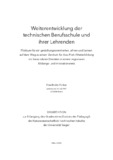Citation link:
http://dx.doi.org/10.25819/ubsi/10431Files in This Item:
| File | Description | Size | Format | |
|---|---|---|---|---|
| Dissertation_Eicker_Friedhelm.pdf | 9.44 MB | Adobe PDF |  View/Open |
| Dokument Type: | Doctoral Thesis | metadata.dc.title: | Weiterentwicklung der technischen Berufsschule und ihrer Lehrenden | Title addition: | Plädoyer für ein gestaltungsorientiertes Lehren und Lernen auf dem Weg zu einem Zentrum für Aus-/Fort-/Weiterbildung mit besonderen Diensten in einem regionalen Bildungs- und Innovationsnetz | Other Titles: | Further development of the technical vocational school and its teachers | Authors: | Eicker, Friedhelm | Institute: | Fakultät IV - Naturwissenschaftlich-Technische Fakultät | Free keywords: | Gestaltungsorientiertes Lehren und Lernen, Regionales Kompetenzzentrum, Berufsbildungs- und Innovationsnetz | Dewey Decimal Classification: | 370 Erziehung, Schul- und Bildungswesen | GHBS-Clases: | IBS | Issue Date: | 2022 | Publish Date: | 2023 | Abstract: | Die Arbeit ist einzuordnen in das Spektrum der aktuellen berufspädagogischen Diskussionen zu den Grundpositionen in der Berufsbildung und zu deren Konsequenzen. Im Kontext allgemeiner Erziehungswissenschaft wird eine kritisch-konstruktive Handlungsorientierung begründet, die unter dem Einfluss des Beruflichen, der Arbeit im Technikbereich, zu einer gestaltungsorientiert-berufswissenschaftlichen Grundorientierung wird. Immer noch verbreitete fach-/ingenieurwissenschaftliche und andere (einzel-)wissenschaftliche Grundpositionen werden überwunden, mit Konsequenzen in Wesentlichem, das Berufsbildung (mit) ausmacht: Der Weiterentwicklung der technischen Berufsschule und ihrem Lehren und Lernen. Die Auseinandersetzung mit aktuellen Vorstellungen zum Gestalten und Lehren sowie zum Lernen führt auf den Weg zu einer neuen/tiefergreifenden Begründung und Ausweisung der gestaltungsorientiert-berufswissenschaftlichen Grundorientierung und daran anschließend zu praxisgreifenden Einsichten. Erwartet wird die Explikation des Grundbegriffes, des Gestaltens als besonderes (gesellschaftliches) Tätigsein und (individuelles) Handeln bzw. konkretes Arbeiten. Schon erste Schritte führen zu Erwartungen an die Weiterentwicklung der Berufsschule. Im Zusammenhang damit zeigen sich Erwartungen an gestaltungsorientiertes Lehren und selbständiges Lernen. Es sind die Berufsschullehrenden, die gemeinsam mit ihren Partner:innen (mit ihren Hochschullehrenden und ihren Berufspädagog:innen in Betrieben und anderen Lehr-/Lern-/Forschungseinrichtungen) ihre Berufsschule und ihr Lernen gestalten und weiterentwickeln – zum Nutzen ihrer Lernenden und zu regionalem (und auch überregionalem) Nutzen. In begründeter Weise wird für die (weitere) Entwicklung und Erprobung eines Bildungs- und Innovationsnetzes plädiert, in dem die Berufsschule agiert und initiiert und in dem arbeits-/ausbildungsbegleitend und integrativ Aus-, Fort- und Weiterbildung (für alle Arbeitenden und Berufspädagog:innen, insbesondere in einem hochflexiblen „Train-the-Trainer-System“), und besondere Dienste (wie bspw. berufsbildungsrelevante Projektberatungen für kleinere regionale Betriebe) angeboten werden. Vor allem wird für die (weitere) Entwicklung und Erprobung gestaltungsorientierten, selbständigen Lernens in Lernprojekten plädiert. Dem dienlich wird ein „Lehr-/Lernrezept“ dargestellt und begründet, das sich bereits in ersten Versuchen bewährt hat. The paper fits into the spectrum of current vocational pedagogical discussions on the basic positions in vocational education and training and on their consequences. In the context of general educational science, a critical-constructive action orientation is founded, which becomes a shaping-oriented basic orientation in vocational science under the influence of the vocational, the work in the technical field. (Single) Scientific basic positions such as technical/engineering ones and others that are still prevalent in many cases are redressed, with consequences in the essentials that make up vocational education and training: the further development of the technical vocational school and its teaching and learning. The examination of current ideas on shaping and teaching, as well as learning, leads to a new/deeper explanation and identification of the basic orientation of shaping-oriented professional science. Subsequently, insights that are relevant to the practice are acquired. It is expected that the basic concept of shaping as a special (social) activity and (individual) action or concrete work will be expounded. The first steps already lead to expectations for the further development of the vocational school. In connection with this, expectations for shaping-oriented teaching and independent learning become apparent. It is the teachers at the vocational schools who, together with their partners (with their college teachers and their vocational educators in companies and other teaching/learning/research institutions), design and further develop their vocational school and their learning. This is to the benefit of their learners as well as regionally (and also nationally/internationally) beneficial. In a well-reasoned way, a plea is made for the (further) development and testing of an education and innovation network in which the vocational school acts and initiates. Additionally, this network offers work/training-accompanying and integrative initial, further and continuing training (for all workers and vocational educators, especially in a highly flexible "train-the-trainer system"), and special services (such as, for example, vocational training-relevant project consultations for smaller regional companies). Above all, a plea for the (further) development and testing of shaping-oriented, independent learning in learning projects is made. To this end, a "teaching/learning recipe" that has already proven itself in initial trials is presented and explained. |
DOI: | http://dx.doi.org/10.25819/ubsi/10431 | URN: | urn:nbn:de:hbz:467-26428 | URI: | https://dspace.ub.uni-siegen.de/handle/ubsi/2642 |
| Appears in Collections: | Hochschulschriften |
This item is protected by original copyright |
Page view(s)
212
checked on Dec 26, 2024
Download(s)
45
checked on Dec 26, 2024
Google ScholarTM
Check
Altmetric
Items in DSpace are protected by copyright, with all rights reserved, unless otherwise indicated.

